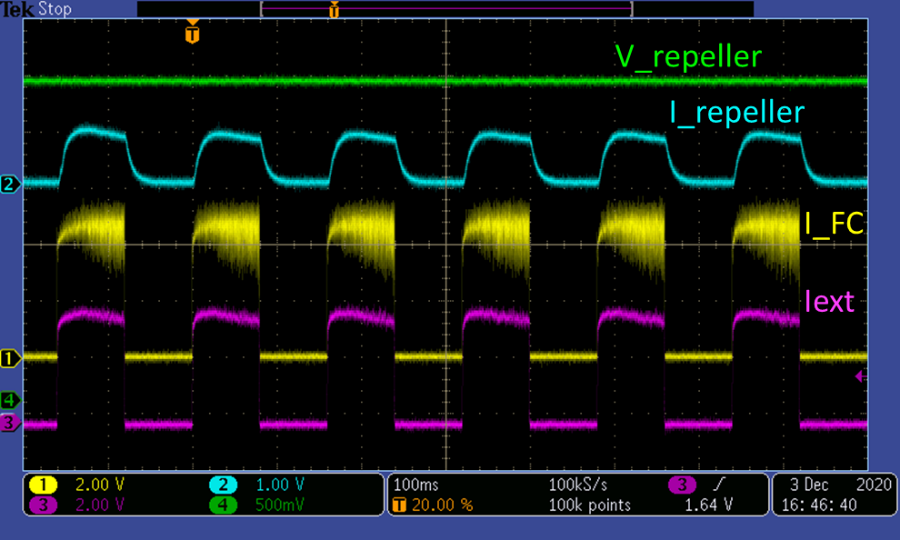Injector conditioning
The Injector operation continued this week: the duty cycle (dc) was increased up to 50% with a very stable beam and 100mA of total extracted current from deuterium plasma. The target performance for the facility inspection (50%dc @100mA) has been reached well ahead of schedule. Next week (last week of operation before the facility inspection, scheduled for 16th December) the efforts will concentrate on decreasing the ramp-up time (it currently takes a few hours to ramp-up the injector to 50% of duty cycle).

Screenshot of the injector oscilloscope on 03 December:
- Duty cycle: 50% (80ms/160ms)
- Total extracted current (red, Iext): ~100 mA
- Yellow: Faraday cup signal (I_FC)
- Blue: Current of repeller PS (I_repeller)
- Green: Voltage of repeller PS (V_repeller)
Radio Frequency (RF) System and RFQ cavities (Radio Frequency Quadrupoles)
This week the RFQ nominal vacuum conditions were resumed switching on all the cryo pumping groups.
The entire RF system has been progressively started to validate the upgrades implemented in a part of the RF chains and to train QST personnel on the entire start-up process (calibration of the RF chains, RF-RFQ interfaces checks). This afternoon we had successfully injected RF in the RFQ cavity!
Once completed the on-going tests and the upgrades validated, the modifications will be propagated in all the modules starting from next week, as soon as the RF system will be stopped. The target being to resume now the RF-RFQ conditioning in the second half of January.
HEBT (High Energy Beam Transport) commissioning
This week was very dense of remote sessions with great support from CIEMAT. The efforts focused on the commissioning and debugging of software for the different Beam Instrumentation equipment installed in the HEBT (SEM grid, Slits, Faraday Cup).
FMEA analyses
The Failure Mode and Effect Analysis (FMEA) of the LIPAc was initiated early this year with the objective to reduce hazards during its maintenance and operation phases. After 2 training sessions, the FMEA was discussed identifying hazards subsystem by subsystem during 26 working sessions. As a result, 59 actions and recommendations were proposed to improve the safety of the project and were included in the final report that was shared this week with the FMEA working group and group coordinators. The identified critical actions will be implemented as prerequisite before resuming the LIPAc beam operation. All the groups including the EU experts participated to this activity, so we can clearly call this achievement an all-hands work resulting from the collaboration of Japan and Europe within the Broader Approach.
Disclaimer: the information reported is not meant to be technically complete and doesn’t cover all the activities currently carried out on LIPAc.


